Deep in the jungle of northeastern Guatemala, in the Department of the Petén, lies a Maya site that has only recently revealed its place in the early history of the region. A new excavation at Nakum by Polish archaeologists has uncovered an intact royal tomb from the Late Classic Period (ca. 600–800 CE) and important vestiges of architecture, rich offerings, and a royal burial from the Protoclassic Period (ca. 50 BCE – ca. 300 CE). Nakum is also noteworthy because it flourished while other Maya lowland sites collapsed.
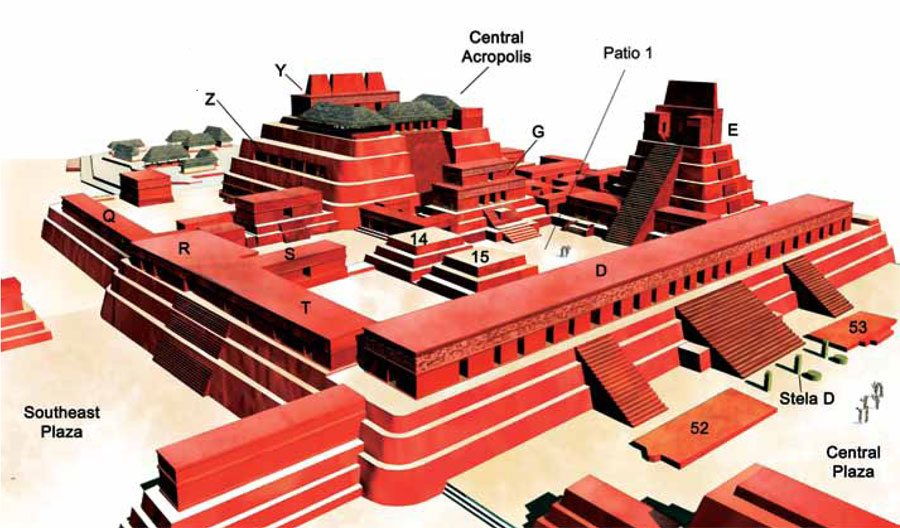
For many years researchers avoided this region due to the lack of local infrastructure and the dangers posed by armed looters and drug smugglers. In fact, Nakum’s nearest neighbor, Naranjo, the largest site in the area, had been thoroughly plundered; more than 200 looters’ trenches and tunnels were documented. Nakum was not spared, and many buildings at the site were looted and destroyed. In 1989 the Guatemalan government moved to preserve these valuable national assets by establishing the Triangulo Park, a protected area defined by the three great Maya cities of Nakum, Naranjo, and Yaxha. Looting has been dramatically reduced, creating an environment where systematic scientific investigations of these sites can take place.
In 2006 a research project—directed by the authors, in association with the Institute of Archaeology of the Jagiellonian University of Cracow, Poland—was initiated at Nakum. Since the project’s inception, several important discoveries have significantly enriched our knowledge of the site and Maya culture in general.
Early Exploration at Nakum
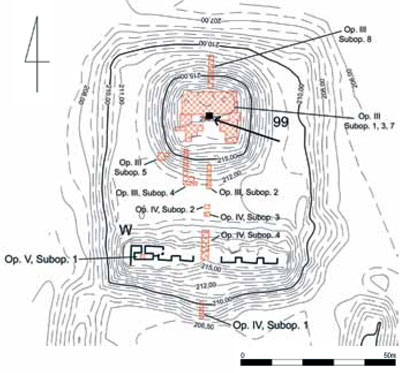
Known only to local people, Nakum was first visited in 1905 by a French traveler, Count Maurice de Perigny. Although he did not excavate, Perigny cleared part of the site and described what he found to the outside world. During the first decades of the 20th century, teams from the Peabody Museum of Harvard University and the Carnegie Institution of Washington mapped the site, preparing plans of the most important buildings and documenting the carved monuments. Nakum was largely forgotten after this, although Nicholas Hellmuth, an American archaeologist, visited the site several times in the 1970s. It was only in the 1990s that the Guatemalan Institute of Anthropology and History (IDAEH) began excavating and restoring the most deteriorated structures as part of the Triangulo Project. This research revealed that Nakum was first settled during the Middle Preclassic Period (ca. 800–300 BCE) and thrived until the end of the Terminal Classic Period (ca. 950 CE). The “Nakum phenomenon” is based on the fact that this site prospered during the 9th and 10th centuries CE, a period marked by the gradual collapse of Classic Maya civilization. During this period almost all southern lowland Maya cities were abandoned and eventually lost to the forest for the next 1,000 years.
Excavations in the Northern Sector
Nakum consists of two separate architectural groups, the Northern and Southern Sectors, connected by a raised Maya sacbe or causeway (called the Perigny Causeway). In antiquity, major construction activity was concentrated in the Southern Sector, primarily in the area of the Acropolis, which contained elite residences and royal palaces.
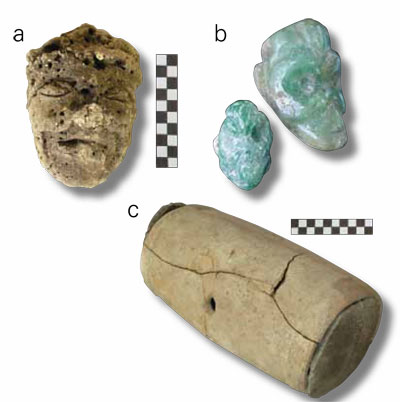
For the last five years, the Polish project has been excavating in Nakum’s previously unexcavated Northern Sector, as well as in the Southern Sector Acropolis complex. Excavations in the Northern Sector have focused mainly on a small pyramid known as Structure 99. On the top of that structure, we found the remains of three buildings, which contained whole clay vessels, complete and broken flint axes, spear points, figurines, and other artifacts scattered within the rooms. Ceramic analysis revealed that these buildings date to the Terminal Classic (ca. 9th–10th centuries CE), a period marked by the downfall of the Lowland Maya cities of southeastern Mexico, northern and central Guatemala, Belize, and the western portions of Honduras. Nakum’s prosperity during these difficult times, documented mainly in the Southern Sector of the site, was likely the result of its advantageous location on the banks of the Holmul River, the main source of water and an important trade route in the region. Nakum’s survival may have also related to the crisis of its powerful neighbors such as Tikal or Naranjo, which once dominated the region.
On the summit of Structure 99, a 2×2 m test pit was opened in 2007 in order to reach the base of the pyramid. We hoped to find earlier substructures as well as material from the fill that could be used to date the building. This venture resulted in the spectacular discovery of two offering deposits nearly 7 m below the summit, containing, among other things, a unique assemblage of nine clay heads of the Maya gods along with jade jewelry, jade monkey heads, ceramic disks, pendants made of human bone, and a cylindrical tube with two round covers. This last object is unique, and its exact function is unknown. It may have been a drum or even a beehive, since in modern times similar hives (though made from wood) are known. If it is a beehive, this find would prove that the Maya were experienced beekeepers more than 2,000 years ago. The clay heads were probably created as portraits of the Maya Gods of the Underworld; in later Maya belief systems, the Underworld consisted of nine levels. In addition to the objects described above, a sharp notched stingray spine used by the Maya for ritual bloodletting was found. Interestingly, both deposits are dated to the still poorly known Protoclassic Period (ca. 50 BCE – ca. 300 CE). The deposits had been placed as foundation offerings prior to the construction of Structure 99.
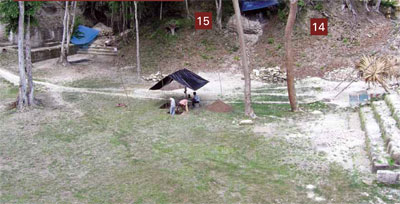
The Discovery of a Royal Tomb in Structure 15
In the Southern Sector, our research focused on the largest courtyard of the great Acropolis complex: Patio 1. During earlier excavations by the Guatemalan Triangulo Project, all of the buildings enclosing the patio had been excavated and restored except two low, heavily destroyed pyramids, Structures 14 and 15, which had been taken over by the jungle.
Since the sun rises in the east, the Maya believed that the east was associated with rebirth and resurrection. Consequently, it is common to see important Maya tombs located in structures on the eastern side of patios and plazas. Thus, one of the aims of our research was to test if Structure 15, located on the eastern side of Patio 1, contained interments of local elites, a hypothesis proposed by one of the authors, Wiesław Koszkul.
During excavations in 2006, a large royal tomb (Burial 1) was found in the upper part of the 12 m high Structure 15. The stone slabs vaulting the chamber were first lifted during the night of June 6. Despite two looters’ trenches running through the upper eastern part of Structure 15, the tomb was untouched. We decided to camp on the top of Structure 15 next to our trench in order to watch over it that night. As soon as the sun rose the following morning, we started exploring the tomb. We found complete clay vessels, jade jewelry, and a human skeleton.
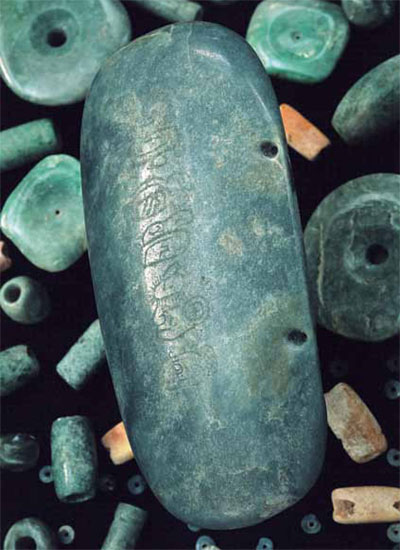
Among the clay vessels was a plate with the image of the Dancing Maize God—one of the most important Maya deities. This vessel can be ascribed to the so-called “Tikal Dancer” style. To date, only five other completely preserved plates with a similar motif have been discovered by archaeological excavations at Maya sites. More than 20 other well-preserved examples are known, but their provenance is unclear, as they were procured through the looting of sites.
The most intriguing and impressive object found was a jade pectoral. Jade was the most precious stone for the Maya, and archaeologists often refer to it as “Maya gold.” In addition, more than 460 jade and shell beads from collars, and other types of jade jewelry, were recovered. The pectoral was discovered in the vicinity of the chest of the skeleton, close to the collars. An ancestor’s face with an elaborate headdress was carved on one side, with a series of glyphs on the reverse side.
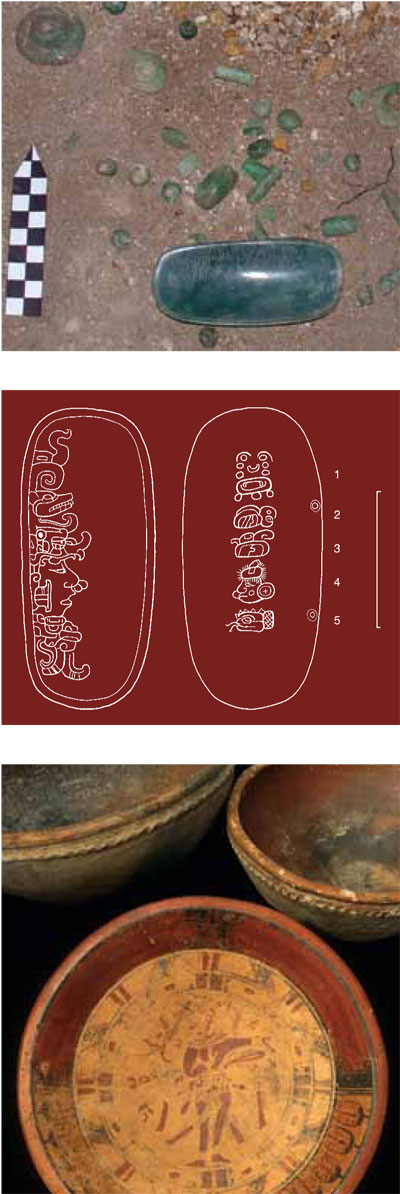
Middle, images and glyphs represented on the jade pectoral from Burial 1 are clearly visible on these line drawings.
Bottom, whole vessels were recovered from Burial 1. In the foreground is the “Tikal Dancer” style plate, with a diameter of 38.2 cm.
The pectoral, 10.6 cm long and 4.9 cm wide, is in the form of a shell. Its location in the tomb indicated that it was part of a larger necklace and was worn in a horizontal position on the chest of the individual interred in Burial 1. Epigraphic analysis of the column of glyphs on the convex side, performed primarily by Simon Martin of the Penn Museum, revealed that the first glyph represents “pectoral.” The next two glyphs together formed what epigraphists call an “emblem glyph.” This consisted of the toponym name of a Maya city or the kingdom of Yaxha (as another epigrapher, David Stuart, has suggested) and a royal title (ajaw). At the end of the inscription, an unknown ruler’s name, Ixi’m Chan or the Maize-(God) Snake, was recorded. The fact that Yaxha, which lies only 12 km south of Nakum, appears in the inscription may indicate that Nakum was once a part of a larger Yaxha kingdom and therefore used the same emblem. Or it may be that Nakum’s royal dynasty came from Yaxha. Other interpretations—that the pectoral was a gift from one of the Yaxha kings or was acquired during war as a trophy—should also be considered.
The skeleton of the person interred in Burial 1 was heavily damaged by small animals that entered the tomb chamber and gnawed the bones while scattering them around the chamber. The remains of these animals (possibly rats) were found within the tomb chamber. The destruction of the bones made it impossible to establish the sex of the individual. Nonetheless, an analysis of the remaining bones by Project Anthropologist Varinia Matute showed that the person from Burial 1 may have been between 35 and 45 years old at the time of death.
Burial 1 is the first royal interment found at Nakum and is also one of the first intact royal tombs in the entire Triangulo Park area. Based on pottery analysis conducted by Project Ceramicist Bernard Hermes, the tomb dates to the 7th century or to the transition between the 7th and 8th centuries CE, when the Late Classic Maya culture flourished. However, it must be mentioned that the jade pectoral stylistically dates to the Early Classic (3rd–5th century CE) and may have been kept as an heirloom by members of the royal family.
Further excavation revealed that Burial 1 was placed within one of two earlier chambers of a temple located on the top of Pyramid 15 (western chamber). The very rich tomb furnishings and the central location of the tomb chamber within the eastern-facing pyramid indicate that the deceased must have been one of the most important rulers of Nakum. This assumption is bolstered by the presence of other offerings, possibly gifts for the dead, placed around the tomb chamber during and after the funeral. Two offering deposits were found in 2008 at the bottom of the temple’s eastern chamber, next to the tomb. The first deposit (number 12) consisted of nine stone points and knives, of which at least four were painted blue, the color used by the ancient Maya to paint victims before they were sacrificed. Thus it is possible that the knives and points were used for ritual purposes. Next to the blades, two large plates, possibly used for cooking tortillas, were found placed one over the other; the top plate was turned upside down, and a jade bead was found between the plates. Another deposit (number 11) included a set of 27 limestone bars. The function of the bars is unknown, although, as some scientists have suggested, similar artifacts may have been used in the weaving process or, when making fishing nets, to determine the spacing of the threads.
Fractures in the royal tomb floor suggested the existence of empty space below the floor, perhaps another tomb or offering deposit. In order to gain a better understanding of Structure 15, we decided to cut through the tomb’s floor and open a shaft that reached to the bottom of the pyramid. A few meters below the floor level, fragments of an entrance and the walls of an earlier temple chamber were revealed. Below it we discovered another burial within a crypt (Burial 2). The grave contained the skeleton of an adult woman; her skull had been placed in a large painted bowl and covered with another painted vessel. This burial, like the two offerings found in the Northern Sector of Nakum, is dated to the Protoclassic Period (ca. 50 BCE – ca. 300 CE). The crypt belongs to one of the first construction phases of Structure 15. The spatial context and the funeral deposit point to the royal status of the buried woman.
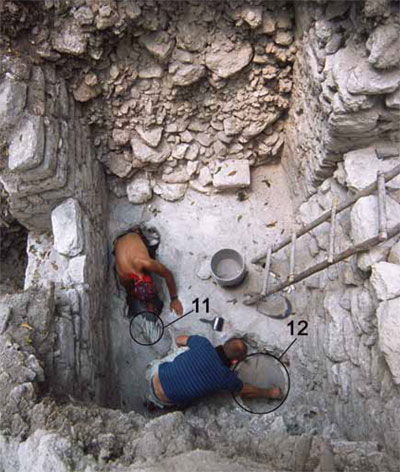
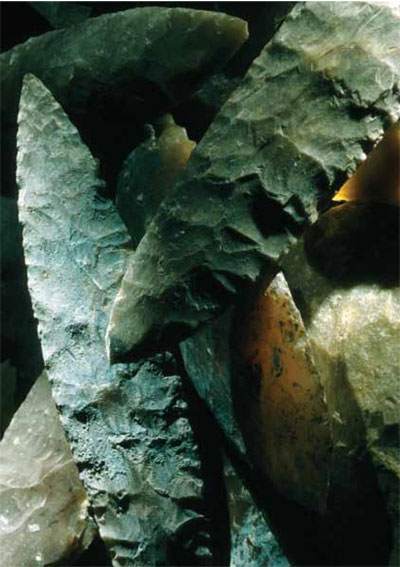
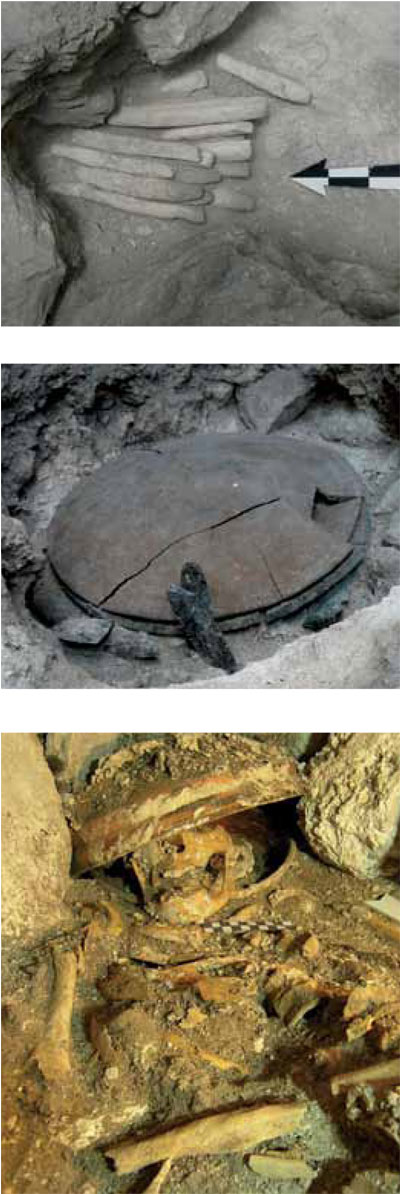
Middle, flint projectile points and knives, found close to clay plates (Offering 12). At least one of the plates may have been used for cooking tortillas since its lower side was covered by a layer of soot.
Bottom, a Protoclassic burial (Burial 2) was discovered in Structure 15. Note that the woman’s skull is covered by a bowl.
A Stucco Frieze and other Finds from Structure 14
From 2007 to 2009, excavations were conducted at Structure 14, a small pyramid located south of Structure 15. Three vaulted chambers of older substructures were encountered about 5 m below the top of the pyramid. Two of the chambers probably belonged to a temple or palace, and the third may have served as a royal tomb or a royal funerary temple. Such funerary temples provided space for the temporary placement of a corpse before the actual funeral. Unfortunately, this chamber had been plundered, possibly in pre-Columbian times. Inside, however, we found many pottery sherds, human teeth, and stucco-modeled sculpture fragments from the façade of an unknown building.
Under the floor of this looted chamber, a partially preserved, 1 m high stucco frieze was discovered, which once embellished the western façade of an older building. Based on its style and associated ceramic material, the frieze dates to the Protoclassic or the Early Classic Period (2nd–6th centuries CE). Unfortunately, the upper part of the frieze was destroyed by the Maya during a later remodeling program. However, enormous legs and the large loincloth of a monster or dwarf flanked by two individuals were visible. It is possible that the individuals shown on both sides of the monster are local rulers or important deities known as the Hero Twins, the miraculously born sons of the Maya Maize God.
In 2008, on the western and northern walls of Structure 14, another interesting discovery was made. We encountered a sophisticated water drain or gutter made of stone and stucco. Such a find is extremely rare, and few comparisons exist.
Although the channel may have been used to simply drain rainwater from the upper terraces of the pyramid, its sophistication suggests a more elaborate purpose such as a ritualistic use. The drain may have been used in elite-sponsored spectacles of the water cult, witnessed by people gathered on the neighboring Patio 1.
Excavations carried out in Structure 14 yielded many examples of beautifully painted pottery. One of these vessels was decorated by pseudoglyphs or stylized hieroglyphs. Another was painted with hieroglyphic text, suggesting that the cup had been used by a king or high-ranking official to drink the elite drink kakaw or cacao. The inscription from the second vessel was probably painted by a novice scribe, as it contained several orthographic errors.
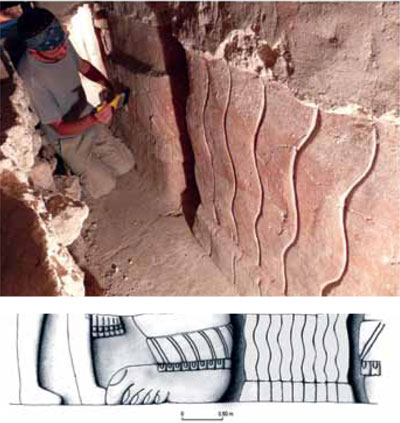
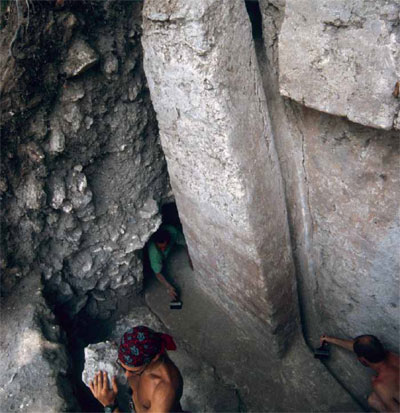
Postscript
Since 2006, excavations at Nakum have uncovered important elite burials and offerings. Several unique finds may significantly enrich our knowledge of Maya macropolitics in this region. Additional evidence may shed light on water management techniques and even early Maya apiculture. The inscription on the jade pectoral from Structure 15 is one of the earliest glyphic records of the area, contributing to our understanding of the still poorly known history of the Maya cities of northeastern Guatemala. Radiocarbon samples and further study of recovered artifacts may help us to establish a more accurate timeframe for the Protoclassic Period, not only for Nakum but also for other neighboring Maya sites.
The exploration of Nakum continued during the spring of 2010. Just before this issue of Expedition went to press, a new carved monument was discovered. The limestone monument, 0.90 m high and 1.45 m wide, was found in the Northern Sector. It is decorated with a representation of a richly attired walking person (a ruler?) and appears to be one of the oldest monuments in the region. Based on its style and associated archaeological material, it is possible to date the monument to the Protoclassic period. Very few neighboring sites have such strong evidence of Protoclassic occupation, and it seems that Nakum was one of the most important and prosperous centers in the Triangulo Park during this period.
Difficult Beginning
Before the authors put the first shovel into the ground at Nakum, some basic necessities had to be attended to, including the establishment of a campsite. Struggling against a tight budget, a bare bones house with basic amenities was constructed close to the ruins. The house served both as a kitchen and a laboratory, and was equipped with furniture that was made from trees from the surrounding jungle and planks brought from Santa Elena, more than 80 kms away. Food and water had to be transported a couple of times a week from the same town.
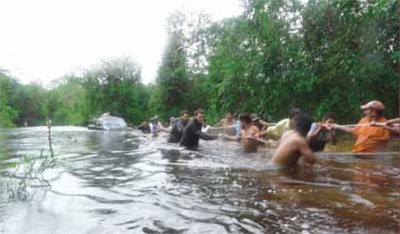
Transportation during the rainy season caused additional hardship; when it began to rain, even an off-road truck could not get through the jungle and would get bogged down in the mud several kilometers from the camp. When this happened, more than a dozen people would hike through the flooded rainforest to heave the car from the wet earth. The most difficult season, in terms of the weather, was in 2008. Due to prolonged rainfall, the level of the Holmul River, which flows close to the site of Nakum, rose nearly 2 m (6 feet). The area around the campsite was completely flooded, forcing the archaeologists to evacuate all their equipment and research records from the camp. This turned out to be quite an adventure with more than 30 people pulling the truck with its load through the river, struggling against a current grown turbulent by the heavy rains. Forced to carry the load on their backs, many arduous hours of trekking through the rainforest finally brought our archaeologists to the ruins of Yaxha, where they were picked up and brought back to Santa Elena. When the Holmul River returned to normal levels, research resumed at Nakum.
Becker, M. Tikal Report 21: Excavations in Residential Areas of Tikal: Groups with Shrines. Philadelphia: University of Pennsylvania Museum, 1999.
Boot, E. An Annotated Overview of “Tikal Dancer” Plates, 2003. Mesoweb: <www.mesoweb.com/features/boot/TikalDancerPlates.pdf>
Brady, J., J. Ball, R. Bishop, D. Pring, N. Hammond, and R. Housley. “The Lowland Maya ‘Protoclassic’: A Reconsideration of its Nature and Significance.” Ancient Mesoamerica 9 (1998):17-38.
Chase, A., D. Chase, E. Zorn, and W. Teeter. “Textiles and the Maya Archaeological Record: Gender, Power, and Status in Classic Period Caracol, Belize.” Ancient Mesoamerica 19 (2008):127-142.
Herbert Mayer, K. “Traditional Maya Beekeepers at Kiuic, Yucatán, Mexico.” Mexicon XXXI (2009):98-101.
Houston, S., D. Stuart, and K. Taube. The Memory of Bones: Body, Being, and Experience among the Classic Maya. Austin: University of Texas Press, 2006.
Koszkul, W., J. Zrałka, B. Hermes, S. Martin, and V. García. “Proyecto Arqueológico Nakum: Resultados de la Temporada 2006.” In XX Simposio de Investigaciones Arqueologicas en Guatemala, 2005, edited by J.P. Laporte, B. Arroyo, and H. Mejía, pp. 651-670. Guatemala: Ministerio de Cultura y Deportes, IDAEH, Asociacion Tikal, 2007.
Looper, M., D. Reents-Budet, and R. Bishop. “Dance on Classic Maya Ceramics.” In To Be Like Gods: Dance in Ancient Maya Civilization, edited by M. G. Looper, pp. 113-150. Austin: University of Texas Press, 2009.
Martin, S. and N. Grube. Chronicle of the Maya Kings and Queens: Deciphering the Dynasties of the Ancient Maya. New York: Thames & Hudson, 2008.
Zrałka, J., W. Koszkul. The Nakum Archaeological Project: Investigations on the Banks of the Holmul River. Annual report available online at the web-page of the Foundation for the Advancement of Mesoamerican Studies Inc. (http://www.famsi.org/reports/06022/index.html)
Zrałka, J. Terminal Classic Occupation in the Maya Sites Located in the Area of Triangulo Park, Peten, Guatemala. Cracow: Jagiellonian University Press, 2008.
